King of Fighters XI theme by Cypher
Download: KingofFightersXI.p3t
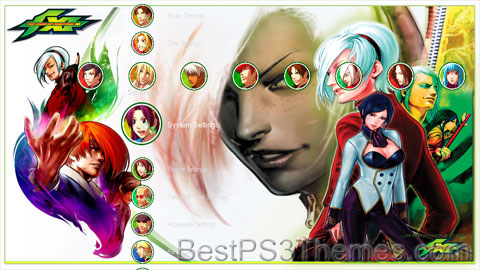
(4 backgrounds, no SD wallpapers)
Redirect to:

The #1 spot for Playstation themes!
King of Fighters XI theme by Cypher
Download: KingofFightersXI.p3t

(4 backgrounds, no SD wallpapers)
Redirect to:
Trinity Blood version 2 theme by Cypher
Download: TrinityBloodV2.p3t
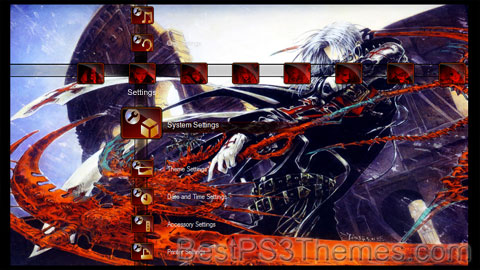
(2 backgrounds, no SD wallpapers)
P3T Unpacker v0.12
Copyright (c) 2007. Anoop Menon
This program unpacks Playstation 3 Theme files (.p3t) so that you can touch-up an existing theme to your likings or use a certain wallpaper from it (as many themes have multiple). But remember, if you use content from another theme and release it, be sure to give credit!
Download for Windows: p3textractor.zip
Instructions:
Download p3textractor.zip from above. Extract the files to a folder with a program such as WinZip or WinRAR. Now there are multiple ways to extract the theme.
The first way is to simply open the p3t file with p3textractor.exe. If you don’t know how to do this, right click the p3t file and select Open With. Alternatively, open the p3t file and it will ask you to select a program to open with. Click Browse and find p3textractor.exe from where you previously extracted it to. It will open CMD and extract the theme to extracted.[filename]. After that, all you need to do for any future p3t files is open them and it will extract.
The second way is very simple. Just drag the p3t file to p3textractor.exe. It will open CMD and extract the theme to extracted.[filename].
For the third way, first put the p3t file you want to extract into the same folder as p3textractor.exe. Open CMD and browse to the folder with p3extractor.exe. Enter the following:
p3textractor filename.p3t [destination path]Replace filename with the name of the p3t file, and replace [destination path] with the name of the folder you want the files to be extracted to. A destination path is not required. By default it will extract to extracted.filename.
Trinity Blood version 1 theme by Cypher
Download: TrinityBloodV1.p3t
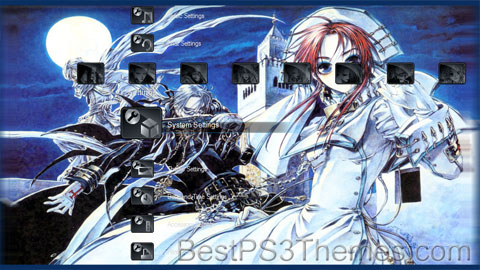
(1 background, no SD wallpaper)
P3T Unpacker v0.12
Copyright (c) 2007. Anoop Menon
This program unpacks Playstation 3 Theme files (.p3t) so that you can touch-up an existing theme to your likings or use a certain wallpaper from it (as many themes have multiple). But remember, if you use content from another theme and release it, be sure to give credit!
Download for Windows: p3textractor.zip
Instructions:
Download p3textractor.zip from above. Extract the files to a folder with a program such as WinZip or WinRAR. Now there are multiple ways to extract the theme.
The first way is to simply open the p3t file with p3textractor.exe. If you don’t know how to do this, right click the p3t file and select Open With. Alternatively, open the p3t file and it will ask you to select a program to open with. Click Browse and find p3textractor.exe from where you previously extracted it to. It will open CMD and extract the theme to extracted.[filename]. After that, all you need to do for any future p3t files is open them and it will extract.
The second way is very simple. Just drag the p3t file to p3textractor.exe. It will open CMD and extract the theme to extracted.[filename].
For the third way, first put the p3t file you want to extract into the same folder as p3textractor.exe. Open CMD and browse to the folder with p3extractor.exe. Enter the following:
p3textractor filename.p3t [destination path]Replace filename with the name of the p3t file, and replace [destination path] with the name of the folder you want the files to be extracted to. A destination path is not required. By default it will extract to extracted.filename.
Air theme by Cypher
Download: Air_2.p3t
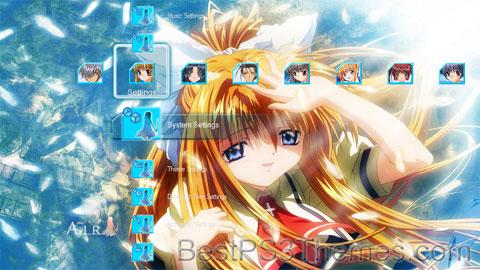
(4 backgrounds)
Redirect to:
This page is a redirect. The following categories are used to track and monitor this redirect:
|
Bleach Chibi theme by Cypher
Download: BleachChibi.p3t
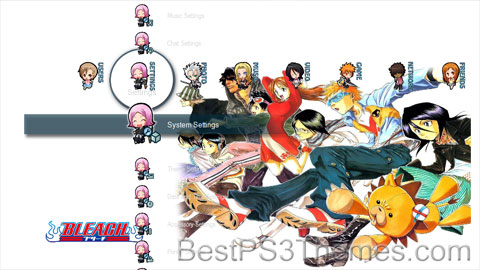
(1 background)
P3T Unpacker v0.12
Copyright (c) 2007. Anoop Menon
This program unpacks Playstation 3 Theme files (.p3t) so that you can touch-up an existing theme to your likings or use a certain wallpaper from it (as many themes have multiple). But remember, if you use content from another theme and release it, be sure to give credit!
Download for Windows: p3textractor.zip
Instructions:
Download p3textractor.zip from above. Extract the files to a folder with a program such as WinZip or WinRAR. Now there are multiple ways to extract the theme.
The first way is to simply open the p3t file with p3textractor.exe. If you don’t know how to do this, right click the p3t file and select Open With. Alternatively, open the p3t file and it will ask you to select a program to open with. Click Browse and find p3textractor.exe from where you previously extracted it to. It will open CMD and extract the theme to extracted.[filename]. After that, all you need to do for any future p3t files is open them and it will extract.
The second way is very simple. Just drag the p3t file to p3textractor.exe. It will open CMD and extract the theme to extracted.[filename].
For the third way, first put the p3t file you want to extract into the same folder as p3textractor.exe. Open CMD and browse to the folder with p3extractor.exe. Enter the following:
p3textractor filename.p3t [destination path]Replace filename with the name of the p3t file, and replace [destination path] with the name of the folder you want the files to be extracted to. A destination path is not required. By default it will extract to extracted.filename.
Zombie Roar theme by Jabyaeye
Download: ZombieRoar.p3t
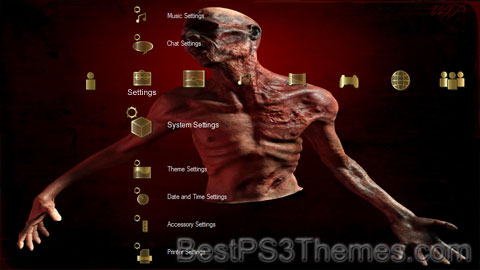
(1 background)
P3T Unpacker v0.12
Copyright (c) 2007. Anoop Menon
This program unpacks Playstation 3 Theme files (.p3t) so that you can touch-up an existing theme to your likings or use a certain wallpaper from it (as many themes have multiple). But remember, if you use content from another theme and release it, be sure to give credit!
Download for Windows: p3textractor.zip
Instructions:
Download p3textractor.zip from above. Extract the files to a folder with a program such as WinZip or WinRAR. Now there are multiple ways to extract the theme.
The first way is to simply open the p3t file with p3textractor.exe. If you don’t know how to do this, right click the p3t file and select Open With. Alternatively, open the p3t file and it will ask you to select a program to open with. Click Browse and find p3textractor.exe from where you previously extracted it to. It will open CMD and extract the theme to extracted.[filename]. After that, all you need to do for any future p3t files is open them and it will extract.
The second way is very simple. Just drag the p3t file to p3textractor.exe. It will open CMD and extract the theme to extracted.[filename].
For the third way, first put the p3t file you want to extract into the same folder as p3textractor.exe. Open CMD and browse to the folder with p3extractor.exe. Enter the following:
p3textractor filename.p3t [destination path]Replace filename with the name of the p3t file, and replace [destination path] with the name of the folder you want the files to be extracted to. A destination path is not required. By default it will extract to extracted.filename.
Team LAG HAZE theme by TeamLAG
Download: TeamLAGHAZE.p3t
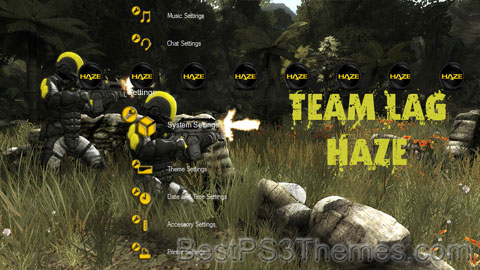
(2 backgrounds)
P3T Unpacker v0.12
Copyright (c) 2007. Anoop Menon
This program unpacks Playstation 3 Theme files (.p3t) so that you can touch-up an existing theme to your likings or use a certain wallpaper from it (as many themes have multiple). But remember, if you use content from another theme and release it, be sure to give credit!
Download for Windows: p3textractor.zip
Instructions:
Download p3textractor.zip from above. Extract the files to a folder with a program such as WinZip or WinRAR. Now there are multiple ways to extract the theme.
The first way is to simply open the p3t file with p3textractor.exe. If you don’t know how to do this, right click the p3t file and select Open With. Alternatively, open the p3t file and it will ask you to select a program to open with. Click Browse and find p3textractor.exe from where you previously extracted it to. It will open CMD and extract the theme to extracted.[filename]. After that, all you need to do for any future p3t files is open them and it will extract.
The second way is very simple. Just drag the p3t file to p3textractor.exe. It will open CMD and extract the theme to extracted.[filename].
For the third way, first put the p3t file you want to extract into the same folder as p3textractor.exe. Open CMD and browse to the folder with p3extractor.exe. Enter the following:
p3textractor filename.p3t [destination path]Replace filename with the name of the p3t file, and replace [destination path] with the name of the folder you want the files to be extracted to. A destination path is not required. By default it will extract to extracted.filename.
Halo 3 theme by itachi1986
Download: Halo3_3.p3t
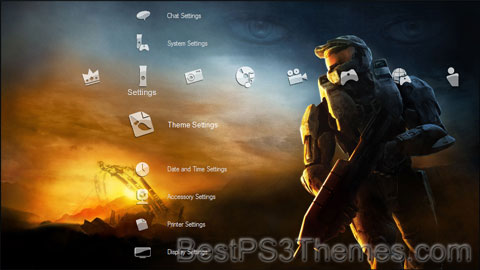
(4 backgrounds)
| Halo 3 | |
|---|---|
 | |
| Developer(s) | Bungie |
| Publisher(s) | Microsoft Game Studios |
| Producer(s) |
|
| Designer(s) |
|
| Programmer(s) |
|
| Artist(s) | Marcus Lehto |
| Writer(s) |
|
| Composer(s) | |
| Series | Halo |
| Platform(s) | Xbox 360 |
| Release | |
| Genre(s) | First-person shooter |
| Mode(s) | Single-player, multiplayer |
Halo 3 is a 2007 first-person shooter video game developed by Bungie for the Xbox 360 console. The third installment in the Halo franchise following Halo: Combat Evolved (2001) and Halo 2 (2004), the game's story centers on the interstellar war between 26th-century humanity, a collection of alien races known as the Covenant, and the alien parasite known as the Flood. The player assumes the role of the Master Chief, a cybernetically enhanced supersoldier, as he battles the Covenant and the Flood. In cooperative play, other human players assume the role of allied alien soldiers. The game features vehicles, weapons, and gameplay elements familiar and new to the series, as well as the addition of saved gameplay films, file sharing, and the Forge map editor—a utility which allows the player to perform modifications to multiplayer levels.
Halo 2 had originally been intended to wrap up the story begun with Combat Evolved, but development difficulties led to a cliffhanger ending. Bungie began developing Halo 3 shortly after Halo 2 shipped. The game was officially announced at E3 2006, and its release was preceded by a multiplayer beta open to select players who purchased the Xbox 360 game Crackdown. Microsoft spent $40 million on marketing the game, in an effort to sell more game consoles and broaden the appeal of the game beyond the established Halo fanbase. Marketing included cross-promotions and an alternate reality game.
Halo 3 was released on September 25 and grossed US$170 million on its first day of release, rising to $300 million in its first week. The game sold in excess of 14.5 million copies and was the best-selling video game of 2007 in the United States. More than one million people played Halo 3 on Xbox Live in the first twenty hours. Overall, the game was well received by critics, with the Forge and multiplayer offerings singled out as strong features; however, some reviewers criticized single-player aspects, especially the plot and campaign layout. Halo 3 is frequently listed as one of the greatest video games of all time. A sequel, Halo 4, released in November 2012, was developed by 343 Industries. Halo 3 was re-released as part of Halo: The Master Chief Collection for the Xbox One in November 2014 and for Microsoft Windows on July 14, 2020.[1]

Halo 3 is a shooter game where players primarily experience gameplay from a first-person perspective. Much of the gameplay takes place on foot, but also includes segments focused on vehicular combat. Gameplay focuses on the "Golden Triangle of Halo": players utilize weapons, grenades, and melee attacks, which are available to a player in most situations. Players may dual-wield some weapons for additional firepower, forgoing the use of grenades and melee attacks. Unlike previous installments, the player's secondary weapon is visible on their player model, holstered or slung across the player's back.[2] Halo 3 introduces support weapons, cumbersome two-handed weapons that slow the player when carried, but offer greatly increased firepower in return.[3]
In addition to weapons, Halo 3 contains a new class of gear called equipment;[4] these items have various effects, ranging from defensive screens to shield regeneration and flares. Only one piece of equipment can be carried at a time.[5] The game's vehicular component has been expanded with new drivable and AI-only vehicles.[6][7]
Halo 3 contains non-gameplay additions, such as Forge, a map-editing tool. Forge enables players to insert and remove game objects, such as weapons, crates and vehicles into existing multiplayer maps.[7] Almost all weapons, vehicles, and interactive objects can be placed and moved on maps with Forge.[8] Players can enter Forge games and edit and manipulate objects in real time. A budget limits the number of objects that can be placed.[9] Players may also save up to 100 films of gameplay to their Xbox 360's hard drive,[10][11] viewing the action from any angle and at different speeds.[12] Halo 3 offers a form of file sharing, where items such as saved films, screenshots, and custom variants can all be uploaded to Bungie's official website. Anyone can browse user created content that has been uploaded to Bungie's website and tag it to automatically download to their console next time they sign into Xbox Live on Halo 3.[5][13]
Halo 3's story or campaign mode can be played alone or cooperatively with up to three other players via Xbox Live or System Link. Instead of each player being an identical character in cooperative play, as in previous Halo games, the first player plays as Master Chief, the second player as the Arbiter, and the final two players controlling the Covenant Elites N'tho 'Sraom and Usze 'Taham. Each player has identical abilities, although their starting weapons vary.[14] Hidden skulls found on each level cause changes to the gameplay when enabled, such as giving the enemies extra health, changing in-game dialogue, or modifying AI behavior.[15] These skulls, as well as the difficulty level and the speed at which the level is completed, provide multipliers to the total score.[5] Players are awarded gamerscore points for unlocking Achievements by reaching a certain score in each level.[16]
Local area network or Xbox Live supports up to sixteen players in multiplayer matches, with game modes including variations of deathmatch and Capture the Flag. Players must actively seek out other players through their Xbox Live Friends list, using the party invite system, or the LAN search feature to play multiplayer matches with their own custom rules and customized maps. If they are connected to Xbox Live however, a player can choose to have the game decide for them the exact rules and map to play on, as well as finding additional people to play against or with, using the "Matchmaking" system (the automated grouping of players of similar skill). A player will decide from a selection of developer designed "playlists" which each contain a certain way to experience the game.[17]
Like other multiplayer Xbox 360 titles, Halo 3 uses a customized version of TrueSkill ranking system for its matchmaking on a per-playlist basis. A linear measure of a player's experience with the matchmade portion of the game and each particular playlist is also tracked (denoted as EXP).[18] To help players have an enjoyable time online, several peace-of-mind features are implemented within easy reach, such as avoid/feedback options on a player's service record, as well as voice chat mute straight from the in-game scoreboard.[19] Like Halo 2, Halo 3 supports downloadable content and updates.[20] The online services for the original Xbox 360 version of the game went offline in January 2022.[21]
Halo 3 is set in a science fiction setting during the years 2552 and 2553. Humanity is at war with a genocidal alliance of alien races known as the Covenant. After years of conflict, a Covenant fleet discovers Earth during Halo 2.[9] "Halos" are massive ringworlds, ranging from thousands to tens of thousands of kilometers in diameter, scattered across the galaxy. These rings were constructed thousands of years ago by a race known as the Forerunners as weapons of last resort against the parasitic alien species known as the Flood. When activated, the Halos would destroy all sentient life in the galaxy, depriving the Flood of its food. The Forerunners disappeared after they activated the rings. In Halo: Combat Evolved, whilst fleeing the Covenant, the UNSC ship Pillar of Autumn stumbled upon one of these ringworlds, Installation 04. Against the wishes of the ring's artificial intelligence (AI) caretaker, 343 Guilty Spark, the human supersoldier Master Chief destroyed the ring to stop the threat from Halo and the Flood. The Covenant, unaware of the destructive nature of the rings, attempt to fire another ring, Installation 05, during Halo 2 in order to fulfill their religious prophecy. One race in the Covenant, the Elites, learn the truth about the rings, and join forces with humanity in order to stop the installation's firing. Though they are successful, the unexpected shutdown triggers a fail-safe protocol, priming all the rings for firing from one location, referred to as the Ark. Still oblivious to the true nature of the rings, the Covenant High Prophet of Truth and the remaining loyalist Covenant proceed to head to Earth, where they believe the Ark is buried.
Halo 3's protagonist is Master Chief Petty Officer John-117, an enhanced supersoldier known as a "Spartan". Master Chief fights alongside the Arbiter, a disgraced Covenant Elite commander. Two other Elite characters, N'tho 'Sraom and Usze 'Taham, appear as the third and fourth players in cooperative play.[14] Supporting characters from previous games return, including human soldiers Avery Johnson and Miranda Keyes.[9] Also playing a role in the story is the Flood leader known as the "Gravemind". In Halo 2, the Gravemind escapes from confinement, invades the Covenant mobile capital city of High Charity, and captures the human AI Cortana.[9]
After the events of the comic tie-in Halo: Uprising,[22] the Master Chief arrives on Earth in east Africa, where he is found by Johnson and the Arbiter. The Chief and company return to a UNSC outpost where Keyes and Lord Hood plan a final effort to stop the Covenant leader, the High Prophet of Truth, from activating a Forerunner artifact the Covenant have excavated. The Chief clears anti-air Covenant defenses so Hood can lead the last of Earth's ships against the Prophet, but Truth activates the buried artifact, creating a slipspace portal which he and his followers enter. A Flood-infested ship crash-lands nearby; Elite forces arrive and vitrify the Flood-infected areas of Earth, stopping the threat. Following a message Cortana left aboard the Flood ship, the Chief, Arbiter, Elites, Johnson, Keyes and their troops follow Truth through the portal. Joining them is 343 Guilty Spark, who aids the Chief as he has no function to fulfill after the destruction of his ringworld.
Traveling through the portal, the humans and Elites discover an immense artificial structure known as the Ark, far beyond the edges of the Milky Way galaxy. Here, Truth can remotely activate all the Halos. The Flood arrive aboard High Charity in full force, beginning to infest the installation. Truth captures Johnson, as he needs a human to use Forerunner technology. Keyes is killed attempting a rescue, and Johnson is forced to activate the rings. Gravemind forges a truce with the Chief and Arbiter to stop Truth and defeat the remainder of his army, rescuing Johnson and halting the installations' activation. After the Arbiter kills Truth, Gravemind turns on the Chief and Arbiter.
The Chief, Arbiter and Guilty Spark discover that the Ark is constructing another Halo to replace the one that the Chief previously destroyed. The Chief decides to activate this Halo; the ringworld would eliminate the Flood infestation on the Ark while sparing the galaxy at large from destruction. To activate the ring, the Chief rescues Cortana, who has the Activation Index of the destroyed Halo, from High Charity and destroys the city. Arriving on the new Halo, Cortana warns that Gravemind is trying to rebuild itself on the ring. The Chief, Arbiter, and Johnson travel to Halo's control room to activate the ring. Guilty Spark explains that because the ring is not yet complete, a premature activation will destroy it and the Ark. When Johnson ignores his warning, Guilty Spark fatally wounds him to protect "his" ring. Although the Chief destroys Guilty Spark, Johnson soon dies of his injuries. Chief activates the ring, and escapes the ring's self-destruction on the UNSC frigate Forward Unto Dawn. However, the force of Halo's blast causes the slipspace portal to collapse, resulting in only the front half of Forward Unto Dawn, carrying the Arbiter, making it back to Earth.
A memorial service is held on Earth for the fallen heroes of the Human-Covenant war, during which the Arbiter and Lord Hood briefly exchange words regarding the fallen Master Chief. After the memorial service, the Arbiter and his Elite brethren depart for their home planet. Meanwhile, the rear half of the Forward Unto Dawn drifts in unknown space. Cortana drops a distress beacon, but acknowledges it may be many years before they are rescued. As the Master Chief enters cryonic sleep, Cortana confides to him that she will miss him, but he comforts her by telling her "wake me when you need me." If the game is completed at the Legendary difficulty level, the scene continues to show the piece of Forward Unto Dawn drifting towards an unknown planet, setting up the events of Halo 4.
Halo 2 was a critical and commercial success, but its development had taken a toll on Bungie. The game's development was fraught and rushed, resulting in the final act of the game's campaign being cut.[23] Bungie was openly critical of the game's shortcomings,[24] and viewed a third Halo game as a chance to do right by fans for Halo 2's problems, as well as the final Halo game the studio would make before moving onto other projects. Lingering dissatisfaction with Bungie's acquisition by Microsoft in 2000 and a desire for more favorable profit-sharing on Halo 3 led to an agreement where Bungie would become an independent studio after shipping a set number of new Halo games.[23]
After Halo 2 shipped, Bungie cofounder Jason Jones went on sabbatical, leaving the Halo 3 team with little direction or leadership; different staff members wrestled over who would take on creative positions for the new game, and no clear creative direction was decided upon. Story writer Joseph Staten took a vacation after coming into conflict with other staff members, meaning there was no clear person who was responsible for the game's story for a portion of development. The story was drafted by a committee, then presented to senior Bungie members. Composer Martin O'Donnell recalled he did not feel the draft would work, as it left out previous characters and plot threads. Having recently seen the film Serenity, he insisted that characters should die to increase the stakes. Staten returned to do edits after the plot had been established.[23]
Halo 2 had popularized online multiplayer matchmaking and social features like player parties and voice chat. The Xbox 360 integrated many similar features into Xbox Live, but changed the underlying system. Designer Max Hoberman recalled that instead of creating new features, he spent a year fixing broken features to get back to parity with Halo 2.[23]
Compared to the harried pace of Halo 2's development which necessitated painful cuts to ship the game on time, Bungie staffers recalled Halo 3's development as much more smooth, with more time to add features like Forge mode.[23]
Bungie remained quiet as to what their new project was, leaving comments in their weekly update alluding to a "new project".[25] The game was officially announced with a real-time cinematic trailer at E3 2006.[26]
In comparison with Halo 2's tight-lipped development, Bungie was more transparent about the process for Halo 3.[23] Bungie kept the public informed on game development via weekly updates on their web site. During development, the game was divided into single player and multiplayer builds; this made debugging and testing the much smaller multiplayer files quicker.[27] While details of Halo 3's multiplayer were widely disseminated in the sixteen months leading up to the release,[28] the single-player aspect of the storyline was kept relatively secret throughout much of the development to build up interest. The first campaign screenshots did not appear until a year after the announcement trailer, on July 5, 2007, as a "tease" for the planned pace of marketing.[29]
A public beta test of the game's online multiplayer features, as well as saved films and file share, took place four months before the full release.[30] Players required a Crackdown disc to play the beta.[31]
AI behavior was enhanced and improved; the behavior of enemy Brutes the player faces was modified, giving them a "pack mentality" that causes the aliens to perform similar actions at the same time and altering gameplay.[4][32]
Halo 3 utilizes a proprietary, in-house graphics engine.[33] It employs graphics technologies such as high dynamic range, global lighting, and depth of field effects within cutscenes.[34] Motion blurring was absent from the beta, but was added to the final game.[35] Most dynamic objects in the game cast real-time shadows on themselves and the environment around them, including the game's plant life. Halo 3 uses normal, bump, and parallax mapping to give surfaces more detail without dramatically increasing the number of polygons. Players can see distances of up to ten miles (16 km) away, all fully three-dimensional.[36] The engine is capable of real-time reflections, but are often unused as Bungie considered it a waste of resources.[37] Halo 3 uses two frame buffers instead of the usual single buffer, allowing Bungie to preserve as much of dynamic range as possible for the game's lighting without adversely affecting the frame rate. As a consequence, the game natively renders at 1152×640 resolution instead of 720p. The image can be upscaled to 1080p by the Xbox 360.[38][39] Halo 3 has also been enhanced for Xbox One X, rendering at 1920p upscaled to 2160p in HDR at a solid 30fps.[40]
As with all titles on the Xbox 360, Halo 3 fully supports 5.1 surround sound audio.[41] In the game, there are over 50,000 pieces of audio, with nearly 40,000 of those being NPC dialogue.[5] This is far more than in either of the preceding Halo titles; Halo 2 had over 15,000 pieces of dialogue. The AI controlling this dialogue is designed to ensure the exchanges flow naturally and convincingly.[36] Separate recordings were made for nearby and distant gunfire to make for a more believable sound experience in the public beta,[42] and the finished game uses Waves Audio plugins to modify dialog and other audio in-game depending on conditions.[43] Distant gunfire sounds, which may first seem like pre-recorded ambient sound, may often be the result of an actual firefight happening elsewhere in the game.[44]
Marty O'Donnell again composed the original score for the game. Some pieces of the game's music are produced with a much larger real orchestra than any pieces in the prior two games. For example, the music for the announcement trailer was recorded with a 60-piece orchestra and a 24-piece choir.[26] Halo 3 is the first game in the series to feature custom soundtracks, allowing players to replace in-game music with their own choices.[45] The Halo 3 Original Soundtrack was released on November 20, 2007.[46] Included on the soundtrack is an original composition submitted by fans and judged by Nile Rodgers, Michael Ostin, and Marty O'Donnell.[47]
Voice actors returning to reprise their roles in Halo 3 include Jen Taylor as Cortana, David Scully as Sergeant Johnson and the Elites, Keith David as the Arbiter, Tim Dadabo as 343 Guilty Spark, Ron Perlman as Lord Hood, Robert Davi as Rtas 'Vadum, and Steve Downes as the voice of Master Chief. The game also features new voices, with Terence Stamp and Justis Bolding replacing Halo 2 voice actors Michael Wincott and Julie Benz as the Prophet of Truth and Miranda Keyes respectively.[48] Additional voices include celebrity presenter Jonathan Ross,[49] Nathan Fillion, Adam Baldwin, Alan Tudyk, Katee Sackhoff, and John DiMaggio.[48] Members of the Halo machinima Red vs. Blue (Burnie Burns, Gus Sorola, Matt Hullum, Jason Saldaña, Geoff Ramsey, and Joel Heyman) have cameo roles.[9]

Microsoft spent more than $40 million marketing Halo 3. The goal of the campaign was to sell more Xbox 360 consoles and widen the appeal of the game beyond the "Halo faithful" to casual as well as hardcore gamers. Marketing took the form of stages, including trailers of the game, real-time cinematics, recorded gameplay sequences, pre-rendered CGI, and live action film.[50] On September 12, 2007, the "Believe" Halo 3 ad campaign, focused on the epic nature of the story and heroism told through dioramas and third party accounts of Master Chief's service, began with the video "Museum" and continued on past the game's release.[51]
Throughout the course of development Bungie released four "developer documentaries" that explained the processes behind creating parts of the game. A large-scale multiplayer beta test was played on Xbox Live with more than 800,000 members of the public being able to take part and experience the game for themselves.[50] Beginning in June 2007, an alternate reality game called Iris involved players in slowly revealing background information for the game.[50] The actual release was met with worldwide launch parties.[52]
Halo 3 also had marketing tie-ins and promotions. PepsiCo announced a new line of soft drink, a variant of Mountain Dew named Game Fuel, branded with the Halo 3 logo and the Master Chief.[53] Much of the advertising focused on appealing to the general public, rather than just hardcore fans of the game; for example, some 7-Eleven stores advertised Halo 3 and sold specialty cups and copies of the game.[54] Gamestation stores in the UK offered a limited edition Master Chief figurine to the first 1000 preorders.[55]
The game's final testing copy before its gold release—codenamed "Epsilon" and confirmed by Bungie to be almost complete[13]—was leaked to the Internet months before the game's release date. Microsoft reacted to this leak by having the Xbox Live accounts of gamers caught playing the leaked copy banned until the year 9999.[56] Retail copies of the game, complete with photographs of the open game box, started to appear on the internet auction site eBay weeks before release,[57] followed by UK catalog retailer Argos accidentally releasing some of their copies a week early. Microsoft's Entertainment and Devices division were quoted as being "disappointed" that the Argos leak happened, but stated they had no intention for punishing them for an "honest mistake".[58] The retail copy was also leaked online over a week before release, with the 6.14 gigabyte file of the game ripped from a disc and downloaded by thousands of people within 24 hours. Videos of the ending of Halo 3, obtained from the leaked copy, were captured and posted on video sharing sites.[59]
Halo 3 was released on September 25, 2007, in three separate retail versions: "Standard", "Limited", and "Legendary". The Standard Edition contains the game disc, manual, and a small poster with the game's control-map and artwork. The Limited Edition, contained in a metal case, contains the game disc, manual, poster, Xbox 360 bonus disc with featurettes, and a hardcover-bound "Bestiarum", a collection of information and art covering the species, cultures, and civilizations of Halo 3. The Legendary Edition contains the game disc, manual, poster, interactive bonus disc, the Bestiarum on a DVD, Legendary DVD containing exclusive content, and a scale replica of the Master Chief's helmet as a case for the three discs. The slip-cover packaging unfolds into a large heavy-stock poster of Master Chief.[60] Some of the Limited Edition versions of Halo 3 were found to have a defect in the hub that kept the discs in place, which could lead to scratched discs. Microsoft introduced a disc replacement program in response.[61][62]
On the day before its official release, 4.2 million units of Halo 3 were in retail outlets.[63]
Halo 3 was made a free download for Xbox Live Gold subscribers through the "Games with Gold" program in October 2013.[64] It became playable on the Xbox One via backwards compatibility in 2017.[65] An Xbox One-native version of the game, presenting the graphics at 1080p and 60 frames per second, was included as part of Halo: The Master Chief Collection for the Xbox One in 2014. Halo 3 was re-released again as part of the Windows version of The Master Chief Collection in 2020.[66]
Halo 3 supports multiplayer map downloadable content as well as game updates via Xbox Live.[67] The first three post-release multiplayer maps, "Standoff", "Rat's Nest", and "Foundry", were released as a pack on December 11, 2007, collectively known as the "Heroic Map Pack".[68] A second group of three maps including a remake of Halo 2 map "Lockout", titled "Blackout", a new map "Ghost Town" and a remake of Halo: Combat Evolved map "Sidewinder", titled "Avalanche" were bundled as the "Legendary Map Pack", on April 15, 2008.[69] These maps introduced visual filters to the Forge pallet, which change the way the maps look.[70] A remake of the Halo: Combat Evolved map "Chill Out", titled "Cold Storage", was released as a free download on "Bungie Day", July 7, 2008.[71] The third multiplayer map pack, titled the "Mythic Map Pack" and consisting of the maps "Orbital", "Assembly", and "Sandbox", was included with the Limited Collectors Edition of Halo Wars.[72] The map pack was released over the Xbox Live Marketplace on April 9, 2009.[73] The fourth and final multiplayer map pack, "Mythic II Map Pack", was released on February 2, 2010. The map pack includes the three new maps from Halo 3: ODST
Windows Vista Ultimate PS3 theme by itachi1986
Download: WindowsVistaUltimatePS3.p3t
Yoshi theme by iRockHard
Download: Yoshi.p3t
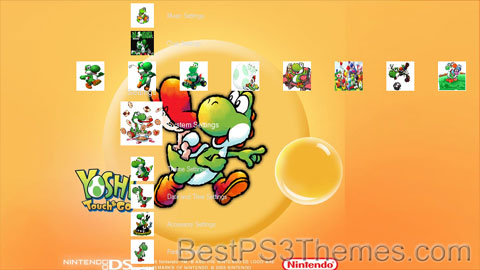
(2 backgrounds)
This article has multiple issues. Please help improve it or discuss these issues on the talk page. (Learn how and when to remove these template messages)
|
| Yoshi | |
|---|---|
| Mario and Yoshi character | |
 Yoshi, as seen in Mario Party 10 | |
| First game | Super Mario World (1990) |
| Created by | Shigefumi Hino[1] |
| Voiced by | Kazumi Totaka (1997–present)[2][3]
Others:
|
| In-universe information | |
| Species | Yoshi |
Yoshi[a] is a fictional dinosaur who appears in video games published by Nintendo. Yoshi debuted in Super Mario World (1990) on the SNES as Mario and Luigi's sidekick. Throughout the mainline Super Mario series, Yoshi typically serves as Mario's trusted steed. With a gluttonous appetite, Yoshi can gobble enemies with his long tongue, and lay eggs that doubly function as projectiles. Yoshi is the title character of the Yoshi series and a supporting character in Mario spin-off games such as Mario Party and Mario Kart, as well as many Mario sports games. He also appears as a playable character in the crossover fighting game series Super Smash Bros. Yoshi is a member of the same-named species, which is distinguished for its wide range of colors.
Yoshi has been well-received, with some critics noting that he is one of the most recognizable characters and one of the best sidekicks in video games. Yoshi's image has also appeared on a range of products, including clothes and collectibles.

Shigeru Miyamoto, the video game designer at Nintendo credited with inventing the Mario series, had wanted Mario to have a dinosaur companion ever since the first release of Super Mario Bros.; however, Nintendo engineers could not add such a character into the game due to the limitations of the Nintendo Entertainment System (NES).[11][12][13] The inspiration for Yoshi can be traced back further, to the green dragon Tamagon in the 1984 video game Devil World: also designed by Miyamoto, both are green lizards that hatch from eggs and can eat enemies with their large mouth, and also emit the same noise when they hatch.[14][15] During the development of Super Mario Bros. 3, Miyamoto had a number of sketches around his desk, including an image of Mario riding a horse.[16][17] Takashi Tezuka, a Mario series developer, speculated that Miyamoto's love of horse riding as well as country and western themes influenced Yoshi's creation.[14][18] The concept of Mario riding a dinosaur also came from the NES video game Excitebike, which featured people riding motorcycles.[14]
Once the more powerful Super NES was released, Miyamoto was finally able to implement Yoshi into the series, putting Yoshi into the video game Super Mario World.[19] As development of Super Mario World progressed, the team opted to set the game in a "dinosaur land", so Tezuka asked designer Shigefumi Hino to draw a reptile-like creature based on Miyamoto's sketches.[16] Hino originally produced a design that Tezuka deemed too reptilian, and "didn't really fit into the Mario world", so he encouraged the designer to create a "cuter" character.[16] Also according to Hino, the reasoning behind the design is that when Mario punches Yoshi, Yoshi is so surprised that his tongue leaps out. This was later "passed off" as Mario merely pointing forward to signal Yoshi to stick out his tongue.[20][21] Alongside the individual Yoshi, Super Mario World also introduced other members of the Yoshi species, characterized by their variety of colors.[22]
Yoshi proved to be popular in this debut, which caused the next game in the series, Super Mario World 2: Yoshi's Island, to focus on the Yoshi species.[11][23] At Miyamoto's prompting, Hino landed on the idea of using Yoshi as the main character of a platforming game, with the goal of being more accessible than previous games in the Mario series.[24] To give the gameplay a more "gentle and relaxed pacing", the levels lack time limits and feature more exploration elements than previous games; Yoshi's flutter jump also makes him easier to control in the air than Mario.[25] In this game, he is responsible for Baby Mario, which leads him to Bowser's Castle, where he is reunited with Baby Luigi. Yoshi successfully pulls the twins together just in time to go home after beating a huge Baby Bowser.[23]
The version of Yoshi seen in the live-action Super Mario Bros. film was realized using a 0.91-metre-tall (3.0 ft) animatronic dinosaur. Yoshi was designed in the film by Dave Nelson. The animatronic had nearly 60 meters (200 ft) of cable and hundreds of moving parts inside of it and was controlled by nine puppeteers. The body was cable-controlled, while the head was radio-controlled. Nelson described the overall process as being "difficult."[26] The creation of Yoshi was handled by a company independent from the filmmakers.[27]
This section may be too long and excessively detailed. (March 2024) |
Super Mario World was the first video game to feature Yoshi as a companion to Mario. Yoshi's rideability was inspired by Miyamoto's love for horseback riding.[28] Super Mario World released during a console war between Nintendo and Sega; Sega's mascot, Sonic the Hedgehog, was considered a "cooler" alternative to Mario, for which Miyamoto apologized.[29][12]
In Super Mario 64, Yoshi makes a minor cameo. A cannon outside the castle becomes available if Mario collects all 120 Power Stars, which can be used to access the Mushroom Castle's roof. There, the player can chat with Yoshi, who congratulates the player on finishing the game by delivering a message from the developers before rewarding Mario with 100 extra lives and a better Triple Jump.[30]
Yoshi is one of the primary protagonists and the first playable character in Super Mario 64 DS, alongside Mario. Princess Peach initially invites Mario to her palace. Yoshi is sleeping on the roof when Mario, Luigi, and Wario arrive at the castle. During this time, Bowser kidnaps Princess Peach, steals the castle's Power Stars, and confines everyone within by placing them in the worlds inside the castle's paintings. The crew reclaims the castle's Power Stars after Yoshi saves Mario, Mario saves Luigi, and Luigi saves Wario, and Mario defeats Bowser and rescues Princess Peach.[31]
In Super Mario Sunshine, Yoshi appears as a mount for Mario, and will only come out of his egg if offered a specific tropical fruit. This fruit gives him the ability to spit a finite stream of juice, though with the tradeoff that he dies as soon as he touches water.[32]
Yoshi makes another cameo in New Super Mario Bros. Wii and New Super Mario Bros. U, this time as a rideable character, as he did in his initial appearance. Yoshi sounds just like he does in Super Mario World. Yoshi's in the colors yellow, light blue, and pink also appear in multiplayer.[33]
Yoshi's appearance is a prominent selling point for Super Mario Galaxy 2, as his gained abilities while eating various fruits aid Mario and Luigi in gathering power stars to foil Bowser's plan to take over the universe. These fruits give him the ability to float, to run on water and against gravity, and to illuminate intangible walkways.[34][35]
Yoshi and his eggs can be found in Super Mario Maker, its Nintendo 3DS port and Super Mario Maker 2 in the Super Mario World and New Super Mario Bros. U game styles, functioning the same as they do in each respective game.[36]
Yoshi appears in Super Mario Odyssey as a capturable character. In the Mushroom Kingdom, he may be found on top of Peach's Castle, just like in Super Mario 64. He can also be discovered in Yoshi Eggs in secret locations accessed via the Dark Side, where he must eat Berries in order for a Power Moon to form. He can also be found in one of the Darker Side's sections. Yoshi may employ his characteristic Flutter Jump and eating powers if captured, similar to his appearance in Super Mario Galaxy 2.[37]
Yoshi appears in Super Mario Bros. Wonder as a playable character for the first time since Super Mario 64 DS, with red, yellow, and blue variants. He brings his signature Flutter Jump to the game, along with other abilities like the ability to be ridden by other players.[38][39]

Yoshi's initial appearance in the Yoshi series was in the puzzle game named after him, where he counted the number of eggs hatched on the side of the screen.[40]
In Yoshi's Cookie, Yoshi appears as a character in V.S. mode. Yoshi has to make horizontal and vertical rows of the same kind of cookie to proceed to the next level. In the Nintendo Puzzle Collection version, there is now a story mode in the game, where Mario and Yoshi are making cookies but get exhausted from the many cookie deliveries.[41]
Bowser conquers Jewelry Land during the events of Yoshi's Safari (It is the only Mario franchise game to feature first-person shooter gameplay and requires the SNES's Super Scope light gun.[42]), kidnapping its rulers, King Fret and Prince Pine, and removing the twelve mystical jewels that gave the kingdom its name and stability, forcing it to split into two realms: the Dark Realm and the Light Realm. Princess Peach then summons Mario and Yoshi to restore order. To help the two, Peach provides Mario a new weapon, the Super Scope, an energy pistol. Mario and Yoshi enter a Warp Pipe with this new weapon, which transports them to Jewelry Land.[42]
The Magikoopa sorcerer Kamek foresees that two newborn brothers will bring ruin to the Koopas and attempts to capture them as the stork carries them to their mother and father in the Mushroom Kingdom one morning years before the events of most Mario games, during the events of Super Mario World 2: Yoshi's Island. While Kamek captures Baby Luigi, his twin brother, Baby Mario, escapes to Yoshi's Island unseen. Fortunately, Yoshi is out walking in the woods that day, and Baby Mario lands unharmed on his saddle, along with a map to Bowser's Castle, where Kamek has stolen Baby Luigi.[43]
Baby Mario was entirely absent in the next Yoshi game, Yoshi's Story, in which Baby Bowser steals a tree that is the source of the Yoshis' happiness, and turns their world into a picture book. Six eggs survive, and hatch into baby Yoshis, the protagonists.[44]
Bowser and his forces attack Yoshi's Island during the events of Yoshi Topsy-Turvy (also known as Yoshi's Universal Gravitation), bringing chaos and anarchy. A spirit named Hongo, by chance, encases the entire island in a storybook to keep Bowser and his army at bay.[45]
In Yoshi Touch & Go, Yoshi must help Baby Mario in safely floating down to the forest at the start of each mode. They can use the stylus to block opponents or move Baby Mario about, as well as to form coin bubbles around non-spiked enemies and to add coins to Baby Mario.[46]
Kamek and Bowser travel back in time in Yoshi's Island DS to try to capture the famous star children (Mario, Luigi, Wario, and Donkey Kong), who had special energy in their bodies that, once in Bowser's hands, would let him to take over the world. Without knowing who the star children were, Kamek and Bowser went out to kidnap all of the Mushroom Kingdom's youngsters, only to have their prey escape their hands and join Yoshi in a journey to save the other kids.[47]
In Yoshi's New Island, Yoshi reappears alongside Baby Mario and Baby Luigi. The game takes place between Super Mario World 2: Yoshi's Island and Yoshi's Island DS.[48]
In Yoshi's Woolly World, Kamek tries to transform all of the Yoshis on Craft Island into Wonder Wools in order to assist Baby Bowser in building a new castle, but he misses Yoshi and Red Yoshi. After that, the two embarked on a quest to restore Craft Island to its former splendor.[49]
Yoshi and the rest of his kind are gathered around the Sundream Stone in Yoshi's Crafted World, which is claimed to make anyone's dream come true. Kamek and Baby Bowser try to get their hands on the stone. The Sundream Stone breaks into five diamonds, which spread around the island for the Yoshis to collect.[50]
Yoshi has appeared in nearly all of the Mario spin-off games, including every game in the Mario Kart series as a playable character[23] (usually as a middleweight or light middleweight) and every Mario Party game to date as a playable character.[51] Yoshis have also made appearances in multiple Mario sports games, such as Mario Tennis,[36] Mario Golf,[52] Mario Super Sluggers,[53] Super Mario Strikers,[54] and Mario & Sonic at the Olympic Games.[55]
Yoshi appeared as a supporting cast member in Mario is Missing for NES, SNES, and MS-DOS in 1993.[56]
The Yoshi species makes its Paper Mario series debut in the fifth chapter of Paper Mario when Mario comes across a village of Yoshis and rescues a group of Yoshi kids after they become lost in the surrounding jungle outside of the village. In the sequel Paper Mario: The Thousand-Year Door Mario rescues a Yoshi egg that hatches into a baby Yoshi, who then joins his team during the third chapter of the game and can be named upon doing so.[32] He also appears in Mario & Luigi: Partners in Time.[32]
Yoshi is a playable character in Mario + Rabbids Kingdom Battle, and he arrives late in the story. After fighting Mecha Jr. in the Lava Pit, he is unlocked.[57] He also returns as a playable character in the sequel Mario + Rabbids Sparks of Hope.[58]
Outside of Super Mario and Yoshi series. Yoshi makes a cameo appearance in Metal Gear (The Twin Snakes and Metal Gear Solid: Snake Eater 3D).[59] In Metal Gear Solid: The Twin Snakes, Yoshi and Mario appears as a dolls that stand on a desk.[60] Additional video game series in which Yoshi has made a cameo appearance includes The Legend of Zelda series (Link's Awakening and Ocarina of Time) as a collectible doll and as a framed photo in Hyrule Castle.[61]
Yoshi is the main character in the English localization of Tetris Attack.[62] Yoshi also appears as a playable character in every installment of the Super Smash Bros. series. He is one of the more unique characters in the series' early history, most notably in how his recovery is a single interruption-resistant Flutter Jump, as opposed to most characters having multiple jumps and special moves to use in sequence. Yoshi's moveset mostly consists of kicks, headbutts, tail attacks, and tongue grabs.[63]
The animated series Super Mario World produced by DIC Entertainment is based on the game of the same name, and similar in plotline to the previous series The Adventures of Super Mario Bros. 3, and The Super Mario Bros. Super Show, except with a different setting. The show features Yoshi as a regular character, voiced by Andrew Sabiston. In the cartoon, Yoshi is a young, friendly, and fleet-of-foot dinosaur who occasionally talks in 3rd person until speaking coherent English from slightly later in the episode "A Little Learning".[64]
Yoshi is featured in the Super Mario Adventures comic serial printed in Nintendo Power, the Nintendo Adventure Books, and the 1993 Super Mario Bros. movie (taking the form of a realistic animatronic dinosaur). Yoshi is King Koopa's pet, and is referred to as a "throwback" by a gang of Koopas. He later joins Princess Daisy's side and selflessly takes a stabbing for her. However, he does reappear at the end of the film in good health. Yoshi first debuts in the first volume of Super Mario-Kun and has since become a frequent companion to Mario. Yoshi is prone to making surprising behaviors and mistakes, prompting Mario to chastise him. Yoshi abandons Mario, Luigi, and Wario in volume 23 when they take advantage of him.[65] Additionally, Yoshi makes an off-screen vocal cameo in The Super Mario Bros Movie during the post-credits scene, with archival audio of Kazumi Totaka being utilized.[66]
Yoshi is also prominently featured within Universal Destinations & Experiences' immersive Super Nintendo World areas. Yoshi appears within the Mario Kart: Bowser's Challenge attraction, and the Universal Studios Japan iteration of the land features a Yoshi's Adventure attraction that is themed to the Yoshi's Island series.[67]
Yoshi is one of the most recognizable characters in the Mario series and is featured in a myriad of Mario merchandise, such as toys, shirts, and figures. Yoshi also appeared in two of Happy Meal promotions of Mario toys, which only featured Mario, Donkey Kong, and Yoshi.[68] Yoshi was also one of the 12 initial amiibo figurines.[69] As part of the release of Yoshi's Woolly World, Yoshi Amiibo made out of yarn are either bundled with the game or sold separately.[70] In addition to the regular-sized green, pink and light blue yarn Yoshi Amiibo, an 8-inch tall, green "Mega Yarn Yoshi" has been released.[71]
Since debuting in Super Mario World, Yoshi has received largely positive reception. An article in Electronic Gaming Monthly commented, "Maybe it was the undeniable dino charm. Maybe it was the insatiable appetite that put fellow foe-eater Kirby to shame. Or maybe it was the status of being Mario's newest best buddy. Whatever the reason, gamers took an immediate liking to Yoshi and his multicolored kin when Super Mario World hatched him into the pantheon of classic game characters."[72] The 2011 issue of the Guinness World Records Gamer's Edition ranked Yoshi at 21st place in their list of the "Top 50 Video Game Characters of All Time", making him the second highest-ranked Mario character on the list, of which Mario himself is ranked first.[73] In a poll conducted in 2008, Yoshi was voted as the third-favorite video game character in Japan, with Cloud Strife and Mario placing second and first, respectively.[74] GameTrailers created a special tribute video for Yoshi for the release of Super Mario Galaxy 2.[75] Yardbarker included Yoshi in their "The most memorable characters from old school Nintendo games", stating that "Yoshi began life in Super Mario World. However, the dinosaur with the lengthy tongue was swiftly spun off into his own video games. There's Yoshi's Island, Yoshi's Cookie, and more. Yoshi is off doing his own thing a lot of the time."[76] Chris Carter of Destructoid described Yoshi, along with Poochy, as "cute as hell" in the "Poochy & Yoshi's Woolly World" promotion.[77] Yoshi was voted one of the finest dinosaurs of pop culture by Jim Vorel of Paste, he said that "Yoshi has been a fan favorite since he first appeared alongside Mario on the Super Nintendo Entertainment System. That's why he's the most famous dinosaur in the world."[78]
Yoshi was also praised for being the best video game sidekick. GameSpy ranked Yoshi as the seventh-best video game sidekick, above Luigi by reasoning that only Yoshi can pull off being green and still be cool.[79] Complex ranked Yoshi at fourth place among "The 25 Most Kickass Dragons in Video Games", adding "Yoshi would have to be one of the best sidekicks of all time".[80] Australia's Official Nintendo Magazine called Yoshi a "cute, trustworthy, a plumber's best friend" and compared Yoshi's loyalty to that of a dog.[14] Yoshi is ranked at 52nd place on GamesRadar's Top 100 video game heroes.